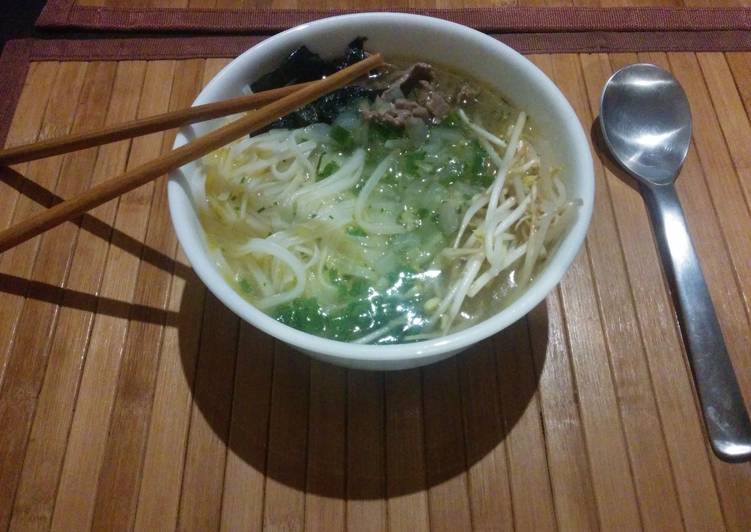
Hello everybody, it is Jim, welcome to my recipe site. Today, I’m gonna show you how to make a distinctive dish, traditional japanese ramen (with beef). One of my favorites food recipes. This time, I’m gonna make it a little bit tasty. This is gonna smell and look delicious.
The other half of Ramen is the soup. Generally speaking, there are three basic types of Ramen soups: Shyoyu (soy sauce), Miso, and Shio (salt). Usually pork, chicken or seafood broth is used for the base of the soup, and that is then seasoned with soy sauce, miso, or salt. Today, I will show you a way to prepare a special dish, traditional japanese ramen (with beef).
Traditional Japanese Ramen (with beef) is one of the most favored of recent trending foods on earth. It is easy, it is quick, it tastes yummy. It’s appreciated by millions every day. They’re nice and they look wonderful. Traditional Japanese Ramen (with beef) is something that I have loved my whole life.
To begin with this particular recipe, we have to first prepare a few components. You can have traditional japanese ramen (with beef) using 16 ingredients and 7 steps. Here is how you cook it.
The ingredients needed to make Traditional Japanese Ramen (with beef):
- Take broth
- Make ready 1 1/2 liter chicken broth
- Prepare 1 tbsp ginger, finely chopped
- Prepare 1 tbsp red pepper, finely chopped (optional, if you like spicy)
- Get 2 tbsp chives, finely chopped
- Make ready 2 tbsp soy sauce
- Take 4 tbsp sesame oil
- Get 2 garlic cloves, finely chopped
- Get 4 grams Hondashi soup stock
- Take 2 tbsp scallion tails (finely chopped)
- Get dish
- Take 300 grams Rice ramen
- Get 4 tbsp scallions (just the tails), finely chopped
- Get 1 Nori (sushi seaweed) cut in small strips (1x3cm)
- Get 2 thin beef steaks, cut in small pieces
- Take 200 grams bean sprouts
Here's a traditional one-pot Japanese beef sukiyaki recipe that you'll cook at the table. It consists of Chinese wheat noodles served in a meat or (occasionally) fish-based broth, often flavored with soy sauce or miso, and uses toppings such as sliced pork (叉焼, chāshū), nori (dried seaweed), menma, and scallions. Ramen is a Japanese term for noodle soup. It contains vegetables, meat, and special seasonings in a broth.
Instructions to make Traditional Japanese Ramen (with beef):
- Prepare all ingredients (chop, cut, etc.)
- Start boiling the chicken broth.
- Meanwhile, heat a pan with the sesame oil, and start cooking the garlic for 1 minute (until golden.) Then add to the pan the soy sauce, 2tbsp of the scallion tails, the chopped chives, the ginger and the red pepper. Cook for ~2 minutes. This will your ramen broth seasoning.
- Pour into the boiling chicken broth the ramen seasoning that you cooked in step 3. Also add the Hondashi soup stock. Keep boiling and stirring the broth for 10 more minutes.
- Meanwhile put the rice ramen in plain boiling water. It will take about 3 or 4 minutes to cook. It should be "al dente." Once cooked, rinse it with cold water to stop the cooking process.
- Prepare the plate: In a deep soup plate put some rice ramen, some 1 tbsp of the remaining scallions, some bean sprouts, 1/4 of the beef and some Nori leave pieces. TIP: try to accommodate these ingredients in the same way for all plates: just looks nice… :)
- Just before serving, pour the prepared broth to fill the plate to serve. Enjoy!
Ramen is a Japanese term for noodle soup. It contains vegetables, meat, and special seasonings in a broth. It is one of the most liked dishes in Japan, and for that reason, you find ramen everywhere you go. We provide authentic taste of traditional Japanese Ramen to our customers by using fresh and natural ingridients only. We have traditional Ramens from all regions of Japan such as HAKATA Tonkotsu, SAPPORO Miso, TOKYO Shoyu, NAGASAKI Seafood.
So that is going to wrap this up for this special food traditional japanese ramen (with beef) recipe. Thanks so much for your time. I am sure you can make this at home. There is gonna be interesting food in home recipes coming up. Remember to save this page on your browser, and share it to your loved ones, friends and colleague. Thanks again for reading. Go on get cooking!

